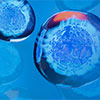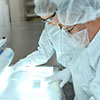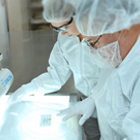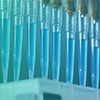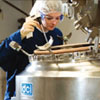Masterflex+Single-use+Flow+Sensor
Numéro de catalogue:
(BOSSBS-6217R-CY5)
Fournisseur:
Bioss
Description:
Nuclear receptor that binds DNA as a monomer to ROR response elements (RORE) containing a single core motif half-site 5'-AGGTCA-3' preceded by a short A-T-rich sequence. Key regulator of cellular differentiation, immunity, peripheral circadian rhythm as well as lipid, steroid, xenobiotics and glucose metabolism. Considered to have intrinsic transcriptional activity, have some natural ligands like oxysterols that act as agonists (25-hydroxycholesterol) or inverse agonists (7-oxygenated sterols), enhancing or repressing the transcriptional activity, respectively. Recruits distinct combinations of cofactors to target gene regulatory regions to modulate their transcriptional expression, depending on the tissue, time and promoter contexts. Regulates the circadian expression of clock genes such as CRY1, ARNTL/BMAL1 and NR1D1 in peripheral tissues and in a tissue-selective manner. Competes with NR1D1 for binding to their shared DNA response element on some clock genes such as ARNTL/BMAL1, CRY1 and NR1D1 itself, resulting in NR1D1-mediated repression or RORC-mediated activation of the expression, leading to the circadian pattern of clock genes expression. Therefore influences the period length and stability of the clock. Involved in the regulation of the rhythmic expression of genes involved in glucose and lipid metabolism, including PLIN2 and AVPR1A. Negative regulator of adipocyte differentiation through the regulation of early phase genes expression, such as MMP3. Controls adipogenesis as well as adipocyte size and modulates insulin sensitivity in obesity. In liver, has specific and redundant functions with RORA as positive or negative modulator of expression of genes encoding phase I and Phase II proteins involved in the metabolism of lipids, steroids and xenobiotics, such as SULT1E1.
UOM:
1 * 100 µl
Numéro de catalogue:
(BOSSBS-12181R-A555)
Fournisseur:
Bioss
Description:
Potassium channels are present in most mammalian cells, where they participate in a wide range of physiologic responses. The protein encoded by this gene is an integral membrane protein and inward-rectifier type potassium channel. The encoded protein, which has a greater tendency to allow potassium to flow into a cell rather than out of a cell, is controlled by G-proteins and is found associated with the sulfonylurea receptor SUR. Mutations in this gene are a cause of familial persistent hyperinsulinemic hypoglycemia of infancy (PHHI), an autosomal recessive disorder characterized by unregulated insulin secretion. Defects in this gene may also contribute to autosomal dominant non-insulin-dependent diabetes mellitus type II (NIDDM), transient neonatal diabetes mellitus type 3 (TNDM3), and permanent neonatal diabetes mellitus (PNDM). Multiple alternatively spliced transcript variants that encode different protein isoforms have been described for this gene. [provided by RefSeq]
UOM:
1 * 100 µl
Numéro de catalogue:
(BOSSBS-11420R-A680)
Fournisseur:
Bioss
Description:
Neuromedin U is a neuropeptide with high activity on smooth muscle. It is widely expressed in gastrointestinal systems and central nervous system (CNS). Peripheral activities of neuromedin U include smooth muscle stimulation, ion transport alterations in the gut and the regulation of local blood flow and adrenocortical function. Neuromedin U receptors 1 and 2 (NMUR1 and NMUR2) are multi-pass membrane proteins that belong to the G-protein coupled receptor 1 family of proteins. Both NMUR1 and NMUR2 act as receptors for the neuromedin U neuropeptide. NMUR1 is detected in peripheral organs, particularly in urogenital and gastrointestinal systems, with highest levels in testis. It's expression in CNS is low, but the protein has been detected in cerebellum, hippocampus, dorsal root ganglia and spinal cord. NMUR2 is predominantly detected in central nervous system with highest levels detected in medulla oblongata, spinal cord and thalamus. It may also be detected in testis but has low levels of expression in peripheral tissues.
UOM:
1 * 100 µl
Numéro de catalogue:
(BOSSBS-11421R-A488)
Fournisseur:
Bioss
Description:
Neuromedin U is a neuropeptide with high activity on smooth muscle. It is widely expressed in gastrointestinal systems and central nervous system (CNS). Peripheral activities of neuromedin U include smooth muscle stimulation, ion transport alterations in the gut and the regulation of local blood flow and adrenocortical function. Neuromedin U receptors 1 and 2 (NMUR1 and NMUR2) are multi-pass membrane proteins that belong to the G-protein coupled receptor 1 family of proteins. Both NMUR1 and NMUR2 act as receptors for the neuromedin U neuropeptide. NMUR1 is detected in peripheral organs, particularly in urogenital and gastrointestinal systems, with highest levels in testis. It’s expression in CNS is low, but the protein has been detected in cerebellum, hippocampus, dorsal root ganglia and spinal cord. NMUR2 is predominantly detected in central nervous system with highest levels detected in medulla oblongata, spinal cord and thalamus. It may also be detected in testis but has low levels of expression in peripheral tissues.
UOM:
1 * 100 µl
Fournisseur:
VWR Collection
Description:
The ILCO 180 Premium offers optimal growth conditions for cell cultures and meets demanding requirements for best possible cell growth and maximum sample safety. This CO₂ incubator comes with a built-in, drift-free infrared CO₂ sensor that can be sterilised. Reliable decontamination is provided by the standard-compliant 180 °C hot air sterilisation routine which completely eliminates contaminants and ensures the inner chamber is completely sterilised. This model has an intuitive menu and user friendly software, also USB port for data download to USB stick and for uploading programs. It can be connected to Ethernet or Wi-Fi networks for remote control from any computer, and users can receive notifications about alarms/events via e-mail.
Fournisseur:
Biotium
Description:
This antibody neutralizes TNF alpha biological activities. It prevents TNF alpha induced apoptosis in Jurkat cells. It also neutralizes HurTNFamediated cytotoxicity of L929 cells and inhibits tumor growth in mice. It protects mice against toxicity of HurTNFa. Tumor Necrosis Factor Alpha (TNF alpha) is a protein secreted by lipopolysaccharide-stimulated macrophages, and causes tumor necrosis when injected into tumor bearing mice. TNF alpha is believed to mediate pathogenic shock and tissue injury associated with endotoxemia. TNF alpha exists as a multimer of two, three, or five non-covalently linked units, but shows a single 17 kDa band following SDS PAGE under non-reducing conditions. TNF alpha is closely related to the 25 kDa protein Tumor Necrosis Factor beta (lymphotoxin), sharing the same receptors and cellular actions. TNF alpha causes cytolysis of certain transformed cells, being synergistic with interferon gamma in its cytotoxicity. Although it has little effect on many cultured normal human cells, TNF alpha appears to be directly toxic to vascular endothelial cells. Other actions of TNF alpha include stimulating growth of human fibroblasts and other cell lines, activating polymorphonuclear neutrophils and osteoclasts, and induction of interleukin 1, prostaglandin E2 and collagenase production.
Fournisseur:
Biotium
Description:
This antibody neutralizes TNF alpha biological activities. It prevents TNF alpha induced apoptosis in Jurkat cells. It also neutralizes HurTNFamediated cytotoxicity of L929 cells and inhibits tumor growth in mice. It protects mice against toxicity of HurTNFa. Tumor Necrosis Factor Alpha (TNF alpha) is a protein secreted by lipopolysaccharide-stimulated macrophages, and causes tumor necrosis when injected into tumor bearing mice. TNF alpha is believed to mediate pathogenic shock and tissue injury associated with endotoxemia. TNF alpha exists as a multimer of two, three, or five non-covalently linked units, but shows a single 17 kDa band following SDS PAGE under non-reducing conditions. TNF alpha is closely related to the 25 kDa protein Tumor Necrosis Factor beta (lymphotoxin), sharing the same receptors and cellular actions. TNF alpha causes cytolysis of certain transformed cells, being synergistic with interferon gamma in its cytotoxicity. Although it has little effect on many cultured normal human cells, TNF alpha appears to be directly toxic to vascular endothelial cells. Other actions of TNF alpha include stimulating growth of human fibroblasts and other cell lines, activating polymorphonuclear neutrophils and osteoclasts, and induction of interleukin 1, prostaglandin E2 and collagenase production.
Fournisseur:
Biotium
Description:
This antibody neutralizes TNF alpha biological activities. It prevents TNF alpha induced apoptosis in Jurkat cells. It also neutralizes HurTNFamediated cytotoxicity of L929 cells and inhibits tumor growth in mice. It protects mice against toxicity of HurTNFa. Tumor Necrosis Factor Alpha (TNF alpha) is a protein secreted by lipopolysaccharide-stimulated macrophages, and causes tumor necrosis when injected into tumor bearing mice. TNF alpha is believed to mediate pathogenic shock and tissue injury associated with endotoxemia. TNF alpha exists as a multimer of two, three, or five non-covalently linked units, but shows a single 17 kDa band following SDS PAGE under non-reducing conditions. TNF alpha is closely related to the 25 kDa protein Tumor Necrosis Factor beta (lymphotoxin), sharing the same receptors and cellular actions. TNF alpha causes cytolysis of certain transformed cells, being synergistic with interferon gamma in its cytotoxicity. Although it has little effect on many cultured normal human cells, TNF alpha appears to be directly toxic to vascular endothelial cells. Other actions of TNF alpha include stimulating growth of human fibroblasts and other cell lines, activating polymorphonuclear neutrophils and osteoclasts, and induction of interleukin 1, prostaglandin E2 and collagenase production.
Numéro de catalogue:
(BOSSBS-1210R-A647)
Fournisseur:
Bioss
Description:
Involved in double-strand break repair and/or homologous recombination. Binds RAD51 and potentiates recombinational DNA repair by promoting assembly of RAD51 onto single-stranded DNA (ssDNA). Acts by targeting RAD51 to ssDNA over double-stranded DNA, enabling RAD51 to displace replication protein-A (RPA) from ssDNA and stabilizing RAD51-ssDNA filaments by blocking ATP hydrolysis. Part of a PALB2-scaffolded HR complex containing RAD51C and which is thought to play a role in DNA repair by HR. May participate in S phase checkpoint activation. Binds selectively to ssDNA, and to ssDNA in tailed duplexes and replication fork structures. May play a role in the extension step after strand invasion at replication-dependent DNA double-strand breaks; together with PALB2 is involved in both POLH localization at collapsed replication forks and DNA polymerization activity. In concert with NPM1, regulates centrosome duplication. Interacts with the TREX-2 complex (transcription and export complex 2) subunits PCID2 and DSS1, and is required to prevent R-loop-associated DNA damage and thus transcription-associated genomic instability. Silencing of BRCA2 promotes R-loop accumulation at actively transcribed genes in replicating and non-replicating cells, suggesting that BRCA2 mediates the control of R-loop associated genomic instability, independently of its known role in homologous recombination (PubMed:24896180).
UOM:
1 * 100 µl
Numéro de catalogue:
(BOSSBS-1210R-FITC)
Fournisseur:
Bioss
Description:
Involved in double-strand break repair and/or homologous recombination. Binds RAD51 and potentiates recombinational DNA repair by promoting assembly of RAD51 onto single-stranded DNA (ssDNA). Acts by targeting RAD51 to ssDNA over double-stranded DNA, enabling RAD51 to displace replication protein-A (RPA) from ssDNA and stabilizing RAD51-ssDNA filaments by blocking ATP hydrolysis. Part of a PALB2-scaffolded HR complex containing RAD51C and which is thought to play a role in DNA repair by HR. May participate in S phase checkpoint activation. Binds selectively to ssDNA, and to ssDNA in tailed duplexes and replication fork structures. May play a role in the extension step after strand invasion at replication-dependent DNA double-strand breaks; together with PALB2 is involved in both POLH localization at collapsed replication forks and DNA polymerization activity. In concert with NPM1, regulates centrosome duplication. Interacts with the TREX-2 complex (transcription and export complex 2) subunits PCID2 and DSS1, and is required to prevent R-loop-associated DNA damage and thus transcription-associated genomic instability. Silencing of BRCA2 promotes R-loop accumulation at actively transcribed genes in replicating and non-replicating cells, suggesting that BRCA2 mediates the control of R-loop associated genomic instability, independently of its known role in homologous recombination (PubMed:24896180).
UOM:
1 * 100 µl
Numéro de catalogue:
(BOSSBS-1922R-CY5.5)
Fournisseur:
Bioss
Description:
Binds the telomeric double-stranded 5'-TTAGGG-3' repeat and plays a central role in telomere maintenance and protection against end-to-end fusion of chromosomes. In addition to its telomeric DNA-binding role, required to recruit a number of factors and enzymes required for telomere protection, including the shelterin complex, TERF2IP/RAP1 and DCLRE1B/Apollo. Component of the shelterin complex (telosome) that is involved in the regulation of telomere length and protection. Shelterin associates with arrays of double-stranded 5'-TTAGGG-3' repeats added by telomerase and protects chromosome ends; without its protective activity, telomeres are no longer hidden from the DNA damage surveillance and chromosome ends are inappropriately processed by DNA repair pathways. Together with DCLRE1B/Apollo, plays a key role in telomeric loop (T loop) formation by generating 3' single-stranded overhang at the leading end telomeres: T loops have been proposed to protect chromosome ends from degradation and repair. Required both to recruit DCLRE1B/Apollo to telomeres and activate the exonuclease activity of DCLRE1B/Apollo. Preferentially binds to positive supercoiled DNA. Together with DCLRE1B/Apollo, required to control the amount of DNA topoisomerase (TOP1, TOP2A and TOP2B) needed for telomere replication during fork passage and prevent aberrant telomere topology. Recruits TERF2IP/RAP1 to telomeres, thereby participating in to repressing homology-directed repair (HDR), which can affect telomere length.
UOM:
1 * 100 µl
Numéro de catalogue:
(BOSSBS-3271R)
Fournisseur:
Bioss
Description:
c-Met, a member of the tyrosine kinase superfamily, is the receptor for hepatocyte growth factor, also known as scatter factor (HGF/SF). The mature c-Met protein is a disulfide-linked heterodimer with Mr=190 kDa composed of a heavily glycosylated alpha subunit that is completely extracellular in localization, and a beta subunit comprising an extracellular ligand binding domain, a single transmembrane domain, and a cytoplasmic tyrosine kinase domain. Cells expressing c-Met include epithelial cells, endothelial cells, blood cells of various types, and glomerular mesenchymal cells.HGF/SF binding to c-Met stimulates receptor dimerization and the phosphorylation of numerous residues within the receptor’s cytoplasmic domain. Signaling proteins that are phosphorylated and/or localized in response to c-Met phosphorylation include: Grb2, Shc, Cbl, Crk, cortactin, paxillin, GAB1, PI3K, FAK, Src, Ras, ERK1 and 2, JNK, PLC gamma, AKT, and STAT3. HGF/SF stimulation of c-Met expressing cells enhances proliferation, migration, morphogenesis, and protease synthesis, characteristics that are associated with invasive cell phenotype. Many types of cancer exhibit sustained c-Met stimulation, overexpression, or mutation, including carcinomas of the colon, breast, ovary, lung, liver, prostate, thyroid, kidney, as well as melanomas and sarcomas. In addition to cancer studies, other research areas in which c-Met is under investigation include organogenesis, organ regeneration, angiogenesis and surgical wound healing.
UOM:
1 * 100 µl
Fournisseur:
SWANN-MORTON
Description:
These Dermatome blades are fitted into a handheld instrument which resembles an electric razor. The blade oscillates and the movement back and forth will "evenly" skim off the surface layers of skin. Electric Dermatomes are preferable for cutting thinner and longer strips of skin with a more homogeneous thickness.
Numéro de catalogue:
(BOSSBS-3686R-CY3)
Fournisseur:
Bioss
Description:
Cellular oxygen sensor that catalyzes, under normoxic conditions, the post-translational formation of 4-hydroxyproline in hypoxia-inducible factor (HIF) alpha proteins. Hydroxylates a specific proline found in each of the oxygen-dependent degradation (ODD) domains (N-terminal, NODD, and C-terminal, CODD) of HIF1A. Also hydroxylates HIF2A. Has a preference for the CODD site for both HIF1A and HIF1B. Hydroxylated HIFs are then targeted for proteasomal degradation via the von Hippel-Lindau ubiquitination complex. Under hypoxic conditions, the hydroxylation reaction is attenuated allowing HIFs to escape degradation resulting in their translocation to the nucleus, heterodimerization with HIF1B, and increased expression of hypoxy-inducible genes. EGLN1 is the most important isozyme under normoxia and, through regulating the stability of HIF1, involved in various hypoxia-influenced processes such as angiogenesis in retinal and cardiac functionality. Target proteins are preferencially recognized via a LXXLAP motif.
UOM:
1 * 100 µl
Numéro de catalogue:
(BOSSBS-3686R-CY7)
Fournisseur:
Bioss
Description:
Cellular oxygen sensor that catalyzes, under normoxic conditions, the post-translational formation of 4-hydroxyproline in hypoxia-inducible factor (HIF) alpha proteins. Hydroxylates a specific proline found in each of the oxygen-dependent degradation (ODD) domains (N-terminal, NODD, and C-terminal, CODD) of HIF1A. Also hydroxylates HIF2A. Has a preference for the CODD site for both HIF1A and HIF1B. Hydroxylated HIFs are then targeted for proteasomal degradation via the von Hippel-Lindau ubiquitination complex. Under hypoxic conditions, the hydroxylation reaction is attenuated allowing HIFs to escape degradation resulting in their translocation to the nucleus, heterodimerization with HIF1B, and increased expression of hypoxy-inducible genes. EGLN1 is the most important isozyme under normoxia and, through regulating the stability of HIF1, involved in various hypoxia-influenced processes such as angiogenesis in retinal and cardiac functionality. Target proteins are preferencially recognized via a LXXLAP motif.
UOM:
1 * 100 µl
Numéro de catalogue:
(BOSSBS-3686R-FITC)
Fournisseur:
Bioss
Description:
Cellular oxygen sensor that catalyzes, under normoxic conditions, the post-translational formation of 4-hydroxyproline in hypoxia-inducible factor (HIF) alpha proteins. Hydroxylates a specific proline found in each of the oxygen-dependent degradation (ODD) domains (N-terminal, NODD, and C-terminal, CODD) of HIF1A. Also hydroxylates HIF2A. Has a preference for the CODD site for both HIF1A and HIF1B. Hydroxylated HIFs are then targeted for proteasomal degradation via the von Hippel-Lindau ubiquitination complex. Under hypoxic conditions, the hydroxylation reaction is attenuated allowing HIFs to escape degradation resulting in their translocation to the nucleus, heterodimerization with HIF1B, and increased expression of hypoxy-inducible genes. EGLN1 is the most important isozyme under normoxia and, through regulating the stability of HIF1, involved in various hypoxia-influenced processes such as angiogenesis in retinal and cardiac functionality. Target proteins are preferencially recognized via a LXXLAP motif.
UOM:
1 * 100 µl
Appel de prix
Le stock de cet article est limité mais peut être disponible dans un entrepôt proche de vous. Merci de vous assurer que vous êtes connecté sur le site afin que le stock disponible soit affiché. Si l'
Le stock de cet article est limité mais peut être disponible dans un entrepôt proche de vous. Merci de vous assurer que vous êtes connecté sur le site afin que le stock disponible soit affiché. Si l'
Ces articles ne peuvent être ajoutés au Panier. Veuillez contacter votre service client ou envoyer un e-mail à vwr.be@vwr.com
Une documentation supplémentaire peut être nécessaire pour l'achat de cet article. Un représentant de VWR vous contactera si nécessaire.
Ce produit a été bloqué par votre organisation. Contacter votre service d'achat pour plus d'informations.
Le produit original n'est plus disponible. Le remplacement représenté est disponible
Les produits marqués de ce symbole ne seront bientôt plus disponibles - vente jusqu'à épuisement de stock. Des alternatives peuvent être disponibles en recherchant le code article VWR indiqué ci-dessus. Si vous avez besoin d'une assistance supplémentaire, veuillez contacter notre Service Clientèle au 016 385 011.
|
|||||||||




